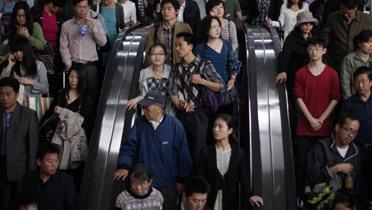Editor’s Note: This paper is a draft version of Chapter 2 in “China’s Emerging Middle Class: Beyond Economic Transformation” (Cheng Li, editor), Washington, DC: Brookings Institution Press, 2010 (forthcoming).
Introduction
The global economy has grown to rely heavily on American consumption. Thanks to a long term downwards trend in personal savings rates from 10 percent in the early 1980s to approximately zero by 2007, the growth of U.S.consumption has been faster than the growth of U.S.GDP, making it a driver of both the U.S.and global economies.[i] At $10 trillion, U.S.private consumption accounts for just under one-fifth of the world economy. In fact, as a source of demand, it is twice the size of the next largest entire economy – Japan – in the world.
The structural force behind large U.S.consumption has been a significant middle class. The middle class is an ambiguous social classification, broadly reflecting the ability to lead a comfortable life. The middle class usually enjoy stable housing, healthcare, educational opportunities (including college) for their children, reasonable retirement and job security, and discretionary income that can be spent on vacation and leisure pursuits. Juliet Schor has argued that it is a “new consumerism” that defines the middle-class: a constant “upscaling of lifestyle norms; the pervasiveness of conspicuous, status goods and of competition for acquiring them; and the growing disconnect between consumer desires and incomes.”[ii] In a more academic vein, Murphy, Shleifer and Vishny emphasize the willingness of the middle class consumer to pay a little extra for quality as a force that feeds investment in production and marketing and drives growth.[iii]
The unlocking of the spending power of the U.S.middle class was achieved in part by financial innovations that allowed for rapid growth in consumer credit, mortgages for an ever-larger segment of the population and home equity withdrawals. Because household wealth grew faster than income, these innovations permitted households to tap into their wealth for current consumption and led to a decline in household saving rates. But the current downturn has brought this process to a halt. U.S.households are saving again in an effort to rebuild lost wealth. The consensus forecast is that this will be a lasting effect of the global financial crisis.[iv]
How can the world economy fill this void in global demand brought on by the retrenchment of the American consumer? All eyes are now turning to Asia, and specifically to the emerging middle class in China and other populous countries, to become the next global consumers. Within Asia there is significant talk of rebalancing towards domestic demand (more specifically domestic consumption) as a way of sustaining growth in the face of potentially sluggish exports. But the policy prescriptions to achieve such a rebalancing are not easy. They involve the creation of a social safety net, medical insurance schemes, and better public education services. In short, Asian consumption is tied in the minds of many analysts to long-term institutional changes.[v] Given the difficulties of implementing such changes, it is hard to be very confident that this rebalancing will happen in the medium term.
This chapter argues that this is too pessimistic a view of Asian consumerism. Instead, we argue that several Asian countries, in particular China and India, have reached a tipping point where large numbers of people will enter the middle class and drive consumption. The policy measures to support such a transformation in China should be focused on increasing the share of household income in GDP – policies which can have almost immediate impacts – rather than lowering household savings.
If this transpires, the world will see a new global middle class—an Asian middle class. There will be a cross-over from the West to the East in the products, fashions, tastes, and designs oriented to the mass middle class. According to our estimates, by 2015, for the first time in 300 hundred years, the number of Asian middle class consumers will equal the number in Europe and North America. By 2021, on present trends, there could be more than 2 billion Asians in middle class households. In China alone, there could be over 670 million middle class consumers, compared with only perhaps 150 million today.
To paraphrase Nobel Laureate Robert Lucas, “the consequences for human welfare involved in questions like these [about economic growth] are simply staggering: once one starts to think about them it is hard to think about anything else.”[vi]
[i] United States Bureau of Economic Analysis (www.bea.gov).
[ii] Juliet Schor, “The New Politics of Consumption: Why Americans want so much more than they need,” Boston Review (Summer 1999).
[iii] Kevin Murphy, Andrei Shleifer and Robert Vishny, “Income Distribution, Market Size and Industrialization,” Quarterly Journal of Economics (August 1989).
[iv] See, for example, William Galston, “The ‘New Normal’ For the U.S. Economy: What Will It Be?,” Brookings Web Commentary (September 2009).
[v] See, for example, Martin Feldstein, “Resolving the Global Imbalance: The Dollar and the U.S.Saving Rate”, Journal of Economic Perspectives, Volume 22 Number 3 (Summer 2008); and Nicholas Lardy, “China: Toward a Consumption-Driven Growth Path”, Peterson Institute for International Economics Policy Brief 06-6 (October 2006).
[vi] Robert Lucas, “On the Mechanics of Economic Development,” Journal of Monetary Economics, Vol. 22, No. 1 (July 1988), p. 5.
The Brookings Institution is committed to quality, independence, and impact.
We are supported by a diverse array of funders. In line with our values and policies, each Brookings publication represents the sole views of its author(s).





